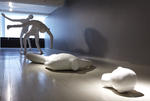Flying Bird is Motionless
Wang Jianwei
汪建伟
Production date
2006
Object Detail
Media
fibreglass, polyurethane, video (colour, sound)
Measurements
4 figures, 300 x 320 cm, 170 x 250 cm, 40 x 300 cm, 35 x 40 cm
video 6 min 30 sec
video 6 min 30 sec
Notes
From the start of the twenty-first century, Wang Jianwei’s work has alluded to Chinese history and classical literature, layered with references to philosophers such as Hegel, Foucault and Žižek in complex multi-dimensional works, often incorporating temporal elements such as video and performance. The Flying Bird is Motionless (2006), for example, juxtaposes a video with four sculptural figures. Wang attributes the concept informing the work to the Greek philosopher Zeno of Elea, who suggested that because time is made up of multiple successive moments, a flying bird is actually stationary. The video depicts a martial arts battle in which a band of heroic brothers are slain: this is a scene from the famous Song Dynasty epic tale, Yangjiajiang, which has been reinterpreted in picture books (lianhuanhua) and TV dramas. Four giant, white fibreglass figures show successive moments in a decapitation, falling backwards as if victims to the swashbuckling swordsmanship of Chinese martial arts movies. Wang suggests that history is like this: a series of unconnected moments, subject to multiple interpretations. He challenges the grand narrative of socialism – and other singular ideologies. Wang Jianwei is interested in instability, in process, in the in-between and the uncertain.
Accession number
2008.077

